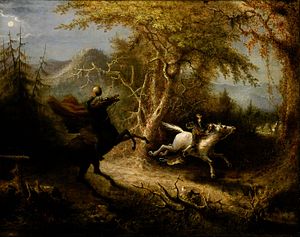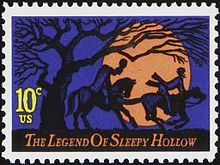Headless Horseman

The Headless Horseman is a mythical figure who has appeared in folklore around the world since the Middle Ages.[1] The figure is traditionally depicted as a rider upon horseback who is missing his head.
Description
Depending on the legend, the Horseman is either carrying his head, or is missing his head altogether, and is searching for it. Examples include the dullahan from Ireland, who is a demonic fairy usually depicted riding a horse and carrying his head under his arm; the titular knight from the English tale Sir Gawain and the Green Knight; and "The Legend of Sleepy Hollow," a short story written in 1820 by American Washington Irving, which has been adapted into several other works of literature and film including the 1949 Disney animated film The Adventures of Ichabod and Mr. Toad and the 1999 Tim Burton film Sleepy Hollow.
In American folklore

The Headless Horseman is a fictional character from the 1820 short story "The Legend of Sleepy Hollow" by American author Washington Irving. The story, from Irving's collection of short stories titled The Sketch Book of Geoffrey Crayon, Gent., has worked itself into known American folklore/legend through literature and film, including the 1999 Tim Burton film Sleepy Hollow.[1]
The legend of the Headless Horseman (also known as "the Headless Hessian of the Hollow") begins in Sleepy Hollow, New York, during the American Revolutionary War. Traditional folklore holds that the Horseman was a Hessian trooper who was killed during the Battle of White Plains on 28 October 1776. He was decapitated by an American cannonball,[2] and the shattered remains of his head were left on the battlefield while his comrades hastily carried his body away. Eventually, they buried him in the cemetery of the Old Dutch Church of Sleepy Hollow, from which he rises as a malevolent ghost, furiously seeking his lost head and wielding a Jack-o'-Lantern as a temporary replacement and/or weapon. Modern versions of the story refer his rides to Halloween, around which time the battle took place.[3]
The Headless Horseman is also a novel by Mayne Reid, first published in monthly serialized form during 1865 and 1866, and subsequently published as a book in 1866,[4][5] based on the author's adventures in the United States. "The Headless Horseman" or "A Strange Tale of Texas" was set in Texas and based on a south Texas folk tale.
In Irish folklore
The dullahan or dulachán ("dark man") is a headless, demonic fairy, usually riding a horse and carrying his head under his arm.[6] He wields a whip made from a human corpse's spine. When the dullahan stops riding, a death occurs. The dullahan calls out a name, at which point the named person immediately dies.[7] In another version, he is the headless driver of a black carriage, the Cóiste Bodhar.[8] A similar figure, the gan ceann ("without a head"), can be frightened away by wearing a gold object or putting one in his path.[9]
In Scottish folklore
The most prominent Scots tale of the headless horseman concerns a man named Ewen decapitated in a clan battle at Glen Cainnir on the Isle of Mull. The battle denied him any chance to be a chieftain, and both he and his horse are headless in accounts of his haunting of the area.[10]
In German folklore
In Germany the stories come mostly from the Rhineland. Rather than by decapitation, the headless horsemen killed their victims simply by touching them. They were revenants who had to wander the earth until they atoned for their sins, sometimes by doing a good deed for a stranger, but instead of showing their gratitude by shaking hands, the stranger and the horseman held a tree branch between them and the branch would wither and die rather than the stranger.[11] Irving travelled in Germany in 1821 and had become familiar with Dutch and German folklore.[12] In particular the last of the "Legenden von Rübezahl" ('Legends of Rübezahl') from Johann Karl August Musäus's literary retellings of German folktales Volksmärchen der Deutschen (1783) is said to have inspired The Legend of Sleepy Hollow.[13]
In popular culture

Book
Washington Irving's gothic story "The Legend of Sleepy Hollow" features a character known as the Headless Horseman believed to be a Hessian soldier who was decapitated by a cannonball in battle.[14]
Comics
The comic book series Chopper, written by Martin Shapiro, is a modern-day reimagining of the Headless Horseman. It features a headless outlaw biker on a motorcycle who collected the souls of sinners. The only people who can see him are those who have consumed a strange new Ecstasy-like drug that triggers their sixth sense and opens a gateway to the afterlife. During the hallucinogenic high, any characters who have committed significant sins are hunted by the headless ghost. Once the drug wears off, the victim is safe and beyond the Headless Horseman's ghostly reach.[15][16][17]
Film
The Headless Horseman appears in "The Legend of Sleepy Hollow" segment of The Adventures of Ichabod and Mr. Toad. Just like the story, the Headless Horseman pursues Ichabod Crane which ends with the Headless Horseman throwing his pumpkin head at him. While it was mentioned what happened to Ichabod's hat was found near the shattered pumpkin, a rumor was mentioned that he has married a wealthy widow in a distant county with children who look like him. In the film the Horseman is depicted as an actual ghost rather than Brom in disguise like in the book.[18] This rendition of the Headless Horseman was also featured in the television series House of Mouse in recurring cameo appearances.
In the 1939 Will Hay comedy film Ask a Policeman, a headless horseman appears in connection with a smuggling ring.[19]
In the 1999 Tim Burton film Sleepy Hollow, the Headless Horseman is the ghost of a murderous Hessian mercenary (performed by Ray Park in Headless Horseman form and portrayed by Christopher Walken in his true form) summoned by Katrina Van Tassel's stepmother Lady Van Tassel to eliminate her enemies after she stole his skull from his grave and used it to control him. After Ichabod Crane returns his skull, the Horseman returns to Hell, taking Lady Van Tassel with him.
The 2007 Sci Fi Channel film Headless Horseman takes the tack that Irving's story was the "white-washed" version and the events in this horror film is the real story. It stars Richard Moll and Billy Aaron Brown and is directed by Anthony C. Ferrante.
The 2022 The Asylum film Headless Horseman directed by Jose Prendes.[20]
Television
The Kolchak: The Night Stalker episode "Chopper" (initially broadcast on January 31, 1975)[21] features a headless motorcyclist who enacts revenge for the loss of his head on a rival biker gang,[22][23] 20 years after his murder.[24]
The 1999 Season 4 Hey Arnold! episode 14 "The Headless Cabbie" depicts a headless cab driver.[25]
Video games
The Headless Horseman is the central character in multiple video games such as Dullahan and Headless Jack. The horseman also appears in many other games such as Assassin's Creed III, The Binding of Isaac: Rebirth, The Elder Scrolls V: Skyrim, Fate/Grand Order, Team Fortress 2 and World of Warcraft as a minor or secret and usually adversarial character.[26]
Miscellaneous
The Headless Horseman mascot for Sleepy Hollow High School, in Westchester County, New York, has been referred to as "America's scariest high school mascot".[27] Since 1983, Conner Prairie Interactive Historic Park in Fishers, Indiana has held a Headless Horseman festival celebrating the legend with a haunted corn maze and other activities.[28]
See also
- Cephalophore, beheaded Christian martyred saints
- Saints Gemolo and Himerius of Bosto
- Headless Mule, a character in Brazilian folklore
- List of ghosts
- List of ghost films
- Headless men
Notes
- ^ a b "Headless Horseman". Mythical Creatures Guide.
- ^ Heath, William; Abbott, William (1901). Memoirs of Major General William Heath. University of California Libraries. New York, W. Abbatt.
- ^ Steiner, Henry John (24 January 2014). "A Phantom is Born? 235 Years Ago". River Journal. Tarrytown, NY: River Journal Inc. Archived from the original on 24 September 2015. Retrieved 14 October 2011.
- ^ Sutherland, John (2013). The Longman Companion to Victorian Fiction (second ed.). Abingdon, Oxon.: Routledge. ISBN 9781408203903.
- ^ Reid, Mayne (1866). The Headless Horseman: A Strange Tale of Texas. London: Richard Bentley. hdl:2027/uiug.30112002996210.
- ^ "5 Famous Monsters That Are Way Scarier In Other Countries". Cracked. 24 October 2012.
- ^ The Dullahan – Ireland's Headless Horseman at Scary For Kids
- ^ The Dullahan at Shee-eire.com
- ^ McKillop, James A Dictionary of Celtic Mythology, 2004, cited at gan ceann, encyclopedia.com
- ^ Fox, David The Headless Horseman[permanent dead link] at Federated Caledonian Societies South Africa
- ^ Hanns Bächtold-Stäubli (Hrsg.): Handwörterbuch des deutschen Aberglaubens. Zehn Bände. de Gruyter, Berlin 1927–1942 (Unveränderter photomechanischer Nachdruck. Ebenda 2000, ISBN 3-11-011194-2).
- ^ "The journals of Washington Irving (Hitherto unpublished)". Library of Congress.
- ^ Hoffman, Daniel (1961). Form and Fable in American Fiction. University of Virginia Press. p. 85 (footnote). ISBN 9780813915258.
- ^ Burstein, Andrew (30 October 2005). "The Politics of Sleepy Hollow". The New York Times. Retrieved 27 October 2017.
- ^ Shapiro, Martin (2011). Chopper. Asylum Press. ISBN 978-1-61724-110-9.
- ^ "Chopper". ComicBookDB.com. Retrieved 2013-03-11.
- ^ "New Chopper Comics Series". Fangoria.com. Archived from the original on 2013-04-10. Retrieved 2013-03-11.
- ^ Gabler, Neal (2006). Walt Disney: The Triumph of American Imagination. New York City: Knopf Publishers. p. 851. ISBN 9780679438229.
- ^ Ask a Policeman (1939): Silver Sirens; Ask a Policeman - Review on The Spinning Image
- ^ "Headless Horseman". IMDB. Retrieved 2023-02-13.
- ^ "Kolchak: The Night Stalker Episode Guide 1975 Season 1 - Chopper, Episode 15". TVGuide.com. Retrieved 2014-02-18.
- ^ Stephen King (8 May 2006). Danse Macabre. ISBN 9781848949140. Retrieved 2014-02-18.
- ^ TV.com. "Kolchak: The Night Stalker - Season 1, Episode 15: Chopper". TV.com. Archived from the original on 2013-11-07. Retrieved 2014-02-18.
- ^ John Kenneth Muir (25 February 2013). Terror Television: American Series, 1970-1999. ISBN 9781476604169. Retrieved 2014-02-18.
- ^ "13 Creepy 'Hey Arnold' Episodes To Watch For Halloween". Bustle. Retrieved 2022-05-18.
- ^ "Dullahan in Video Games: Hangin' With the Headless Horseman". storytellerkim.com. 21 October 2019. Retrieved 2020-09-09.
- ^ Spiewak, Stephen (October 31, 2013). "Sleepy Hollow's Headless Horseman: America's scariest high school mascot". MaxPreps.com. CBS Broadcasting Inc. Archived from the original on 1 February 2018. Retrieved 6 August 2018.
- ^ Contreras, Natalia E. "Here's everything you need to know about the Headless Horseman Festival at Conner Prairie". The Indianapolis Star. Retrieved 2022-03-14.
